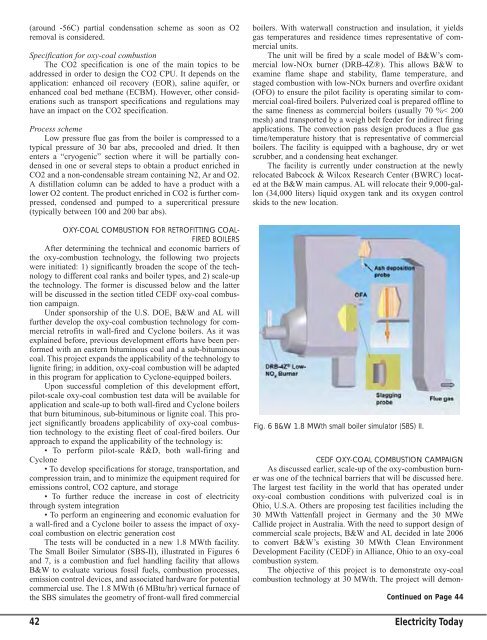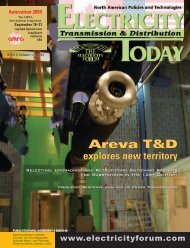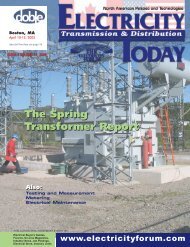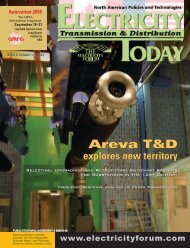in this issue - Electricity Today Magazine
in this issue - Electricity Today Magazine
in this issue - Electricity Today Magazine
You also want an ePaper? Increase the reach of your titles
YUMPU automatically turns print PDFs into web optimized ePapers that Google loves.
(around -56C) partial condensation scheme as soon as O2<br />
removal is considered.<br />
Specification for oxy-coal combustion<br />
The CO2 specification is one of the ma<strong>in</strong> topics to be<br />
addressed <strong>in</strong> order to design the CO2 CPU. It depends on the<br />
application: enhanced oil recovery (EOR), sal<strong>in</strong>e aquifer, or<br />
enhanced coal bed methane (ECBM). However, other considerations<br />
such as transport specifications and regulations may<br />
have an impact on the CO2 specification.<br />
Process scheme<br />
Low pressure flue gas from the boiler is compressed to a<br />
typical pressure of 30 bar abs, precooled and dried. It then<br />
enters a “cryogenic” section where it will be partially condensed<br />
<strong>in</strong> one or several steps to obta<strong>in</strong> a product enriched <strong>in</strong><br />
CO2 and a non-condensable stream conta<strong>in</strong><strong>in</strong>g N2, Ar and O2.<br />
A distillation column can be added to have a product with a<br />
lower O2 content. The product enriched <strong>in</strong> CO2 is further compressed,<br />
condensed and pumped to a supercritical pressure<br />
(typically between 100 and 200 bar abs).<br />
OXY-COAL COMBUSTION FOR RETROFITTING COAL-<br />
FIRED BOILERS<br />
After determ<strong>in</strong><strong>in</strong>g the technical and economic barriers of<br />
the oxy-combustion technology, the follow<strong>in</strong>g two projects<br />
were <strong>in</strong>itiated: 1) significantly broaden the scope of the technology<br />
to different coal ranks and boiler types, and 2) scale-up<br />
the technology. The former is discussed below and the latter<br />
will be discussed <strong>in</strong> the section titled CEDF oxy-coal combustion<br />
campaign.<br />
Under sponsorship of the U.S. DOE, B&W and AL will<br />
further develop the oxy-coal combustion technology for commercial<br />
retrofits <strong>in</strong> wall-fired and Cyclone boilers. As it was<br />
expla<strong>in</strong>ed before, previous development efforts have been performed<br />
with an eastern bitum<strong>in</strong>ous coal and a sub-bitum<strong>in</strong>ous<br />
coal. This project expands the applicability of the technology to<br />
lignite fir<strong>in</strong>g; <strong>in</strong> addition, oxy-coal combustion will be adapted<br />
<strong>in</strong> <strong>this</strong> program for application to Cyclone-equipped boilers.<br />
Upon successful completion of <strong>this</strong> development effort,<br />
pilot-scale oxy-coal combustion test data will be available for<br />
application and scale-up to both wall-fired and Cyclone boilers<br />
that burn bitum<strong>in</strong>ous, sub-bitum<strong>in</strong>ous or lignite coal. This project<br />
significantly broadens applicability of oxy-coal combustion<br />
technology to the exist<strong>in</strong>g fleet of coal-fired boilers. Our<br />
approach to expand the applicability of the technology is:<br />
• To perform pilot-scale R&D, both wall-fir<strong>in</strong>g and<br />
Cyclone<br />
• To develop specifications for storage, transportation, and<br />
compression tra<strong>in</strong>, and to m<strong>in</strong>imize the equipment required for<br />
emissions control, CO2 capture, and storage<br />
• To further reduce the <strong>in</strong>crease <strong>in</strong> cost of electricity<br />
through system <strong>in</strong>tegration<br />
• To perform an eng<strong>in</strong>eer<strong>in</strong>g and economic evaluation for<br />
a wall-fired and a Cyclone boiler to assess the impact of oxycoal<br />
combustion on electric generation cost<br />
The tests will be conducted <strong>in</strong> a new 1.8 MWth facility.<br />
The Small Boiler Simulator (SBS-II), illustrated <strong>in</strong> Figures 6<br />
and 7, is a combustion and fuel handl<strong>in</strong>g facility that allows<br />
B&W to evaluate various fossil fuels, combustion processes,<br />
emission control devices, and associated hardware for potential<br />
commercial use. The 1.8 MWth (6 MBtu/hr) vertical furnace of<br />
the SBS simulates the geometry of front-wall fired commercial<br />
42<br />
boilers. With waterwall construction and <strong>in</strong>sulation, it yields<br />
gas temperatures and residence times representative of commercial<br />
units.<br />
The unit will be fired by a scale model of B&W’s commercial<br />
low-NOx burner (DRB-4Z®). This allows B&W to<br />
exam<strong>in</strong>e flame shape and stability, flame temperature, and<br />
staged combustion with low-NOx burners and overfire oxidant<br />
(OFO) to ensure the pilot facility is operat<strong>in</strong>g similar to commercial<br />
coal-fired boilers. Pulverized coal is prepared offl<strong>in</strong>e to<br />
the same f<strong>in</strong>eness as commercial boilers (usually 70 %< 200<br />
mesh) and transported by a weigh belt feeder for <strong>in</strong>direct fir<strong>in</strong>g<br />
applications. The convection pass design produces a flue gas<br />
time/temperature history that is representative of commercial<br />
boilers. The facility is equipped with a baghouse, dry or wet<br />
scrubber, and a condens<strong>in</strong>g heat exchanger.<br />
The facility is currently under construction at the newly<br />
relocated Babcock & Wilcox Research Center (BWRC) located<br />
at the B&W ma<strong>in</strong> campus. AL will relocate their 9,000-gallon<br />
(34,000 liters) liquid oxygen tank and its oxygen control<br />
skids to the new location.<br />
Fig. 6 B&W 1.8 MWth small boiler simulator (SBS) II.<br />
CEDF OXY-COAL COMBUSTION CAMPAIGN<br />
As discussed earlier, scale-up of the oxy-combustion burner<br />
was one of the technical barriers that will be discussed here.<br />
The largest test facility <strong>in</strong> the world that has operated under<br />
oxy-coal combustion conditions with pulverized coal is <strong>in</strong><br />
Ohio, U.S.A. Others are propos<strong>in</strong>g test facilities <strong>in</strong>clud<strong>in</strong>g the<br />
30 MWth Vattenfall project <strong>in</strong> Germany and the 30 MWe<br />
Callide project <strong>in</strong> Australia. With the need to support design of<br />
commercial scale projects, B&W and AL decided <strong>in</strong> late 2006<br />
to convert B&W’s exist<strong>in</strong>g 30 MWth Clean Environment<br />
Development Facility (CEDF) <strong>in</strong> Alliance, Ohio to an oxy-coal<br />
combustion system.<br />
The objective of <strong>this</strong> project is to demonstrate oxy-coal<br />
combustion technology at 30 MWth. The project will demon-<br />
Cont<strong>in</strong>ued on Page 44<br />
<strong>Electricity</strong> <strong>Today</strong>












